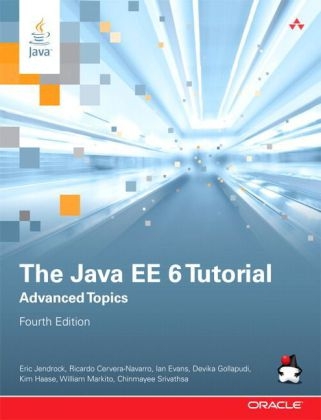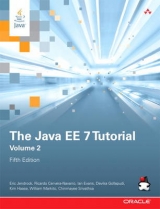
The Java EE 6 Tutorial
Addison-Wesley Educational Publishers Inc (Verlag)
978-0-13-708186-8 (ISBN)
- Titel erscheint in neuer Auflage
- Artikel merken
This guide–which builds on the concepts introduced in The Java EE 6 Tutorial: Basic Concepts, Fourth Edition–contains advanced material, including detailed introductions to more complex platform features and instructions for using the latest version of the NetBeans IDE and the GlassFish Server, Open Source Edition.
This book introduces the Java Message Service (JMS) API and Java EE Interceptors. It also describes advanced features of JavaServer Faces, Servlets, JAX-RS, Enterprise JavaBeans components, the Java Persistence API, Contexts and Dependency Injection for the Java EE Platform, web and enterprise application security, and Bean Validation. The book culminates with three new case studies that illustrate the use of multiple Java EE 6 APIs.
Eric Jendrock leads the Java EE Tutorial team and documents Java Servlet technology and Java security. Ricardo Cervera-Navarro improved examples and added content in the JAX-RS and resource connections technology areas. Ian Evans documents Enterprise JavaBeans, Java Persistence API, Bean Validation, Java Transaction API, JAX-RS, and JAX-WS. Devika Gollapudi documented JavaServer Faces technology. Kim Haase documents Contexts and Dependency Injection for the Java EE platform, JavaServer Faces technology, and Java Message Service (JMS). William Markito, a member of the Platform Technology Solutions group at Oracle, created and documented the Duke’s Forest case study and also created examples for some of the technologies. Chinmayee Srivathsa documents resource connections.
Preface xxi
Part I: Introduction 1
Chapter1: Overview 3
Java EE 6 Platform Highlights 4
Java EE Application Model 5
Distributed Multitiered Applications 6
Java EE Containers 13
Web Services Support 15
Java EE Application Assembly and Deployment 17
Packaging Applications 17
Development Roles 19
Java EE 6 APIs 21
Java EE 6 APIs in the Java Platform, Standard Edition 6 and 7 32
GlassFish Server Tools 35
Chapter 2: Using the Tutorial Examples 37
Required Software 37
Starting and Stopping the GlassFish Server 41
Starting the Administration Console 42
Starting and Stopping the Java DB Server 43
Building the Examples 43
Tutorial Example Directory Structure 44
Getting the Latest Updates to the Tutorial 45
Debugging Java EE Applications 45
Part II: The Web Tier 47
Chapter 3: JavaServer Faces Technology: Advanced Concepts 49
The Lifecycle of a JavaServer Faces Application 50
Partial Processing and Partial Rendering 56
The Lifecycle of a Facelets Application 56
User Interface Component Model 57
Chapter 4: Using Ajax with JavaServer Faces Technology 69
Overview of Ajax 70
Using Ajax Functionality with JavaServer Faces Technology 70
Using Ajax with Facelets 71
Sending an Ajax Request 73
Monitoring Events on the Client 75
Handling Errors 76
Receiving an Ajax Response 77
Ajax Request Lifecycle 78
Grouping of Components 78
Loading JavaScript as a Resource 79
The ajaxguessnumber Example Application 81
Further Information about Ajax in JavaServer Faces Technology 85
Chapter 5: Composite Components: Advanced Topics and Example 87
Attributes of a Composite Component 87
Invoking a Managed Bean 88
Validating Composite Component Values 89
The compositecomponentlogin Example Application 89
Chapter 6: Creating Custom UI Components and Other Custom Objects 95
Determining Whether You Need a Custom Component or Renderer 97
Understanding the Image Map Example 100
Steps for Creating a Custom Component 105
Creating Custom Component Classes 106
Delegating Rendering to a Renderer 114
Implementing an Event Listener 117
Handling Events for Custom Components 119
Defining the Custom Component Tag in a Tag Library Descriptor 120
Using a Custom Component 121
Creating and Using a Custom Converter 123
Creating and Using a Custom Validator 128
Binding Component Values and Instances to Managed Bean Properties 133
Binding Converters, Listeners, and Validators to Managed Bean Properties 138
Chapter 7: Configuring JavaServer Faces Applications 141
Using Annotations to Configure Managed Beans 142
Application Configuration Resource File 144
Configuring Managed Beans 146
Registering Application Messages 155
Using Default Validators 159
Registering a Custom Validator 159
Registering a Custom Converter 160
Configuring Navigation Rules 161
Registering a Custom Renderer with a Render Kit 165
Registering a Custom Component 167
Basic Requirements of a JavaServer Faces Application 168
Chapter 8: Uploading Files with Java Servlet Technology 175
The @MultipartConfigAnnotation 175
The getPartsand getPart Methods 176
The fileuploadExample Application 177
Chapter 9: Internationalizing and Localizing Web Applications 183
Java Platform Localization Classes 183
Providing Localized Messages and Labels 184
Date and Number Formatting 187
Character Sets and Encodings 188
Part III: Web Services 191
Chapter 10: JAX-RS: Advanced Topics and Example 193
Annotations for Field and Bean Properties of Resource Classes 193
Subresources and Runtime Resource Resolution 197
Integrating JAX-RS with EJB Technology and CDI 198
Conditional HTTP Requests 199
Runtime Content Negotiation 200
Using JAX-RS with JAXB 202
The customer Example Application 209
Part IV: Enterprise Beans 225
Chapter 11: A Message-Driven Bean Example 227
Overview of the simplemessage Example 227
The simplemessage Application Client 228
The Message-Driven Bean Class 229
Running the simplemessage Example 231
Chapter 12: Using the Embedded Enterprise Bean Container 235
Overview of the Embedded Enterprise Bean Container 235
Developing Embeddable Enterprise Bean Applications 236
The standalone Example Application 239
Chapter 13: Using Asynchronous Method Invocation in Session Beans 241
Asynchronous Method Invocation 241
The async Example Application 244
Part V: Contexts and Dependency Injection for the Java EE Platform 249
Chapter 14: Contexts and Dependency Injection for the Java EE Platform: Advanced Topics 251
Using Alternatives in CDI Applications 251
Using Producer Methods, Producer Fields, and Disposer Methods in CDI Applications 254
Using Predefined Beans in CDI Applications 256
Using Events in CDI Applications 257
Using Interceptors in CDI Applications 260
Using Decorators in CDI Applications 262
Using Stereotypes in CDI Applications 263
Chapter 15: Running the Advanced Contexts and Dependency Injection Examples 265
The encoder Example: Using Alternatives 265
The producermethods Example: Using a Producer Method to Choose a Bean Implementation
271
The producerfields Example: Using Producer Fields to Generate Resources 273
The billpayment Example: Using Events and Interceptors 280
The decorators Example: Decorating a Bean 286
Part VI: Persistence 291
Chapter 16: Creating and Using String-Based Criteria Queries 293
Overview of String-Based Criteria API Queries 293
Creating String-Based Queries 294
Executing String-Based Queries 295
Chapter 17: Controlling Concurrent Access to Entity Data with Locking 297
Overview of Entity Locking and Concurrency 297
Lock Modes 299
Chapter 18: Using a Second-Level Cache with Java Persistence API Applications 303
Overview of the Second-Level Cache 303
Specifying the Cache Mode Settings to Improve Performance 305
Part VII: Security 309
Chapter 19: Java EE Security: Advanced Topics 311
Working with Digital Certificates 311
Authentication Mechanisms 316
Using Form-Based Login in JavaServer Faces Web Applications 321
Using the JDBC Realm for User Authentication 324
Securing HTTP Resources 328
Securing Application Clients 331
Securing Enterprise Information Systems Applications 332
Configuring Security Using Deployment Descriptors 336
Further Information about Security 337
Part VIII: Java EE Supporting Technologies 339
Chapter 20: Java Message Service Concepts 341
Overview of the JMS API 341
Basic JMS API Concepts 345
The JMS API Programming Model 348
Creating Robust JMS Applications 359
Using the JMS API in Java EE Applications 368
Further Information about JMS 376
Chapter 21: Java Message Service Examples 377
Writing Simple JMS Applications 378
Writing Robust JMS Applications 406
An Application That Uses the JMS API with a Session Bean 416
An Application That Uses the JMS API with an Entity 421
An Application Example That Consumes Messages from a Remote Server 429
An Application Example That Deploys a Message-Driven Bean on Two Servers 436
Chapter 22: Bean Validation: Advanced Topics 449
Creating Custom Constraints 449
Customizing Validator Messages 450
Grouping Constraints 451
Chapter 23: Using Java EE Interceptors 453
Overview of Interceptors 453
Using Interceptors 455
The interceptor Example Application 460
Chapter 24: The Resource Adapter Example 463
The Resource Adapter 463
The Message-Driven Bean 464
The Web Application 464
Running the mailconnector Example 465
Part IX: Case Studies 469
Chapter 25: Duke’s Bookstore Case Study Example 471
Design and Architecture of Duke’s Bookstore 471
The Duke’s Bookstore Interface 472
Running the Duke’s Bookstore Case Study Application 477
Chapter 26: Duke’s Tutoring Case Study Example 479
Design and Architecture of Duke’s Tutoring 479
Main Interface 481
Administration Interface 486
Running the Duke’s Tutoring Case Study Application 487
Chapter 27: Duke’s Forest Case Study Example 491
Design and Architecture of Duke’s Forest 492
Building and Deploying the Duke’s Forest Case Study Application 506
Running the Duke’s Forest Application 509
Index 513
| Erscheint lt. Verlag | 24.1.2013 |
|---|---|
| Verlagsort | New Jersey |
| Sprache | englisch |
| Maße | 179 x 232 mm |
| Gewicht | 850 g |
| Themenwelt | Informatik ► Programmiersprachen / -werkzeuge ► Java |
| Mathematik / Informatik ► Informatik ► Web / Internet | |
| ISBN-10 | 0-13-708186-3 / 0137081863 |
| ISBN-13 | 978-0-13-708186-8 / 9780137081868 |
| Zustand | Neuware |
| Haben Sie eine Frage zum Produkt? |
aus dem Bereich



